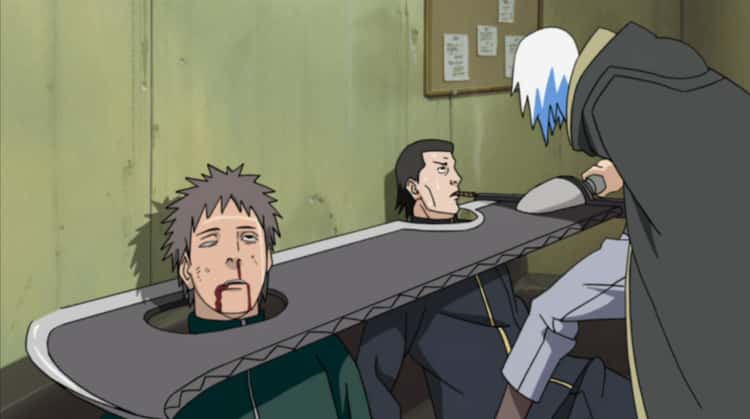While the most prominent fighting method used in Naruto is jutsu, the characters also wield a wide range of impressive weapons. These weapons aren’t just featureless swords. Some of them have elaborate powers or intricate designs, and many are inspired by Japanese mythology. These weapons are fascinating, and there’s plenty of details and trivia to learn about them.
What are some things you didn’t know about weapons in Naruto? The Kiba, dual swords belonging to the Seven Swordsmen of the Mist, appeared in the anime and then made their way into the manga along with their formerly anime-exclusive wielder Raiga Kurosuki. Also, did you know that the Sword of Nunoboko is likely a reference to a Japanese creation myth?
1. The Anime Makes It Harder For Suigetsu To Get Ahold Of The Kubikiribocho

In the manga, all Suigetsu has to do to get his hands on the Kubikiribōchō is take it from Zabuza’s grave. Not exactly the world’s easiest task, but it’s still just one thing.
In the anime, it’s a little more complicated. The sword had already been swiped by a crime boss named Tenzen Daikoku who wanted the sword as a personal trophy since it had cut down so many of his men. Suigetsu had to forcefully take it from one of Tenzen’s bodyguards.
2. Which Sword Belonged To Mangetsu?

Mangetsu Hozuki is known to have mastered all seven of the swords belonging to the Seven Swordsmen of the Mist. But which one did he use himself? This hasn’t been directly confirmed, but it has been implied.
When the former swordsmen are reincarnated, both Mangetsu and Fuguki Suikazan lack their original swords. That’s because both the Hiramekarei and the Samehada have current owners. Since it’s known that Fuguki is the former owner of the Samehada, it can be inferred that Mangetsu’s primary sword was the Hiramekarei.
3. The Supervibrato Lightning Release Swords Are Easily Replaceable

Killer B and many other Kumogakure ninja use Supervibrato Lightning Release Swords to channel their lightning chakra and enhance their lightning-based moves.
B uses five of them. They often get lost, but B is able to easily replace them once he returns to his village. If he’s nowhere near home and loses his swords, he’ll have to improvise.
4. The Treasured Tools Were Inspired By ‘Journey to the West’

The Treasured Tools of the Sage of Six Paths are a collection of items that are said to have been used by the sage himself. All are immensely powerful, and all were inspired by the classic Chinese novel Journey to the West. The story features two demon brothers, the Gold Horn Great King and the Sliver Horn Great King, who own five sacred items called the Amber Purifying Pot (琥珀の浄瓶, Kohaku no Jōhei), the Seven Star Sword (七星剣, Shichiseiken), the Banana Palm Fan (芭蕉扇, Bashōsen), the Golden Canopy Rope (幌金縄, Kōkinjō), and the Crimson Gourd (紅葫蘆, Benihisago).
These are, of course, the same names as the items in Naruto. Not all have the same functions, but the pot and the gourd can suck people into themselves and destroy them from within, which is similar to what these objects can do in the anime.
5. The Shuriken Are Specifically Called Hira Shuriken

Though they’re only referred to as shuriken in the series, the shuriken that appear in Naruto are actually a specific variety of shuriken called the hira shuriken.
In real life, hira shuriken have a hole in the middle and look a bit like a star. The exact shape and construction of the blade varies depending on the ninja school that produced them, so you can actually identify their origin based on their appearance. This does not appear to be the case in Naruto, since most shuriken look alike.
6. The Shichiseiken Has Roots In Taoism

One of the treasured tools of the Sage of Six Paths is called the Shichiseiken or Seven Stars (七星). This name stems from the seven stars of the Big Dipper, an important concept within Taoism. Swords with this name are said to have the ability to destroy all things evil and protect all things good.
Considering the Shichiseiken’s ability to sever a person’s word soul and have them permanently sucked into the Benihisago, one would hope that it’s being used for good!
7. The Sword of Totsuka Has Mythological Origins

The Sword of Totsuka isn’t physical but ethereal. It’s stored in a gourd belonging to Itachi’s susano-o armor. Kishimoto didn’t say exactly where he got this concept from, but it seems related to both the hyōtan-kozō and a myth about the god Susanoo-no-Mikoto.
The hyōtan-kozō is a yokai that lives in a gourd. Susanoo-no-Mikoto is said to have defeated Yamata-no-Orochi by first getting him drunk and then striking him with a sword called the Totsuka no Tsurugi.
8. The Kurosawa Is Most Likely Named After A Famous Director

Mifune, a leader from the Land of Samurai, wields a sword called the Kurosawa.
This sword was most likely named after acclaimed director Akira Kurosawa. While Kishimoto has not directly confirmed this, it seems nearly certain, especially because a character named Mifune appears in Kurosawa’s film Yojimbo.
9. The Sword Of Nunoboko References A Creation Myth

According to legend, Hagoromo Ōtsutsuki used the Sword of Nunoboko to literally shape the world. This is probably a nod to the Amenonuhoko (天沼矛), a legendary weapon whose name means “Heavenly Jeweled Spear.”
According to Shinto mythology, it was used to create the primordial landmass called Onogoro-shima where there was once only sea. Two gods named Izanami and Izanagi used the spear to create the island.
